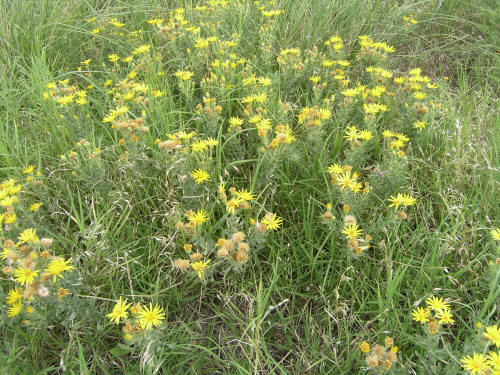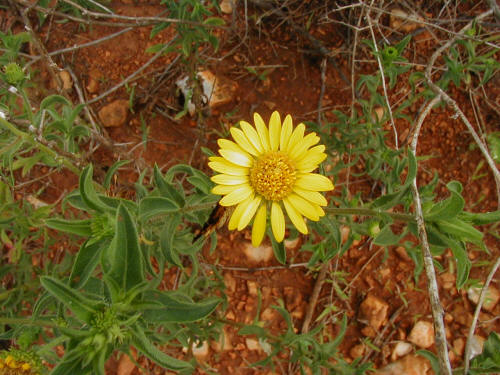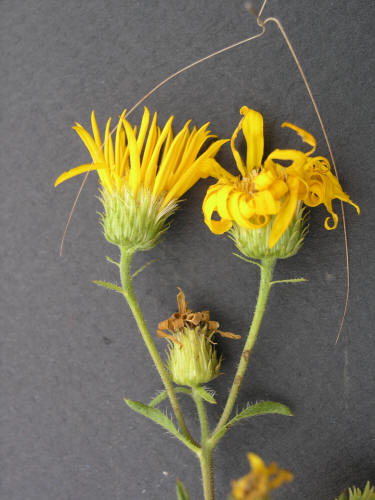Prairie Goldenaster
Prairie Goldenaster
Heterotheca camporum (Greene) Shinners var. camporum Semple
(also listed as Heterotheca villosa Pursh.)
Asteraceae (Aster Family)
▲ new growth emerging from roots in spring

▲ new growth springing from base of last year's plant stems

▲ ▼ mature flowering plants


▲ mature plant
▲ ▼ mature, flowering plants
▲ ▼ mature, flowering plants mature, flowering plants
▲ ▼ mature, flowering plants
▲ ▼ "flowers" (head inflorescences)


▲ ▼ "flowers" (head inflorescences)


▲ seedhead

▲ reddish-brown stems
▲ population near a pasture in Missouri
Heterotheca camporum (Greene) Shinners var. camporum, Prairie Goldenaster, Lemon-yellow False Goldenaster, Goldenaster, Camphorweed: (Bayer Code: not known; US Code HECA8)
- U.S. native, rhizome-producing perennial that grows 0.5-2.5 feet tall, with generally upright, much-branched, green to reddish-brown or brown stems; both leaves and stems are covered with long, outspread hairs, and may have none to many resin glands
- Leaves are lanceolate, with smooth margins and covered with long hairs; leaf margins may twist or curve along their length; leaves lack petioles
- Flower heads are at stem tips, sometimes appearing clustered due to close branching; each head is 0.75-1.5 inch diameter, with 15-30 yellow ray florets (“petals"), and 30-60 or more yellow center disk florets
- Bracts below the inflorescence form a cylindric shape and are linear to lanceolate, hairy, with pointed tips, and are arranged in several overlapping rows; green midvein of bracts usually prominent, and bracts may have resin glands; bract tips may be purplish
- Flowering is from mid-summer through mid-autumn
- After flowering the center disk of the flower head becomes a globe of tan hairs from the pappus (parachute-like hairs) attached to the mature
- Prefers full sun, dry soils and is found in pastures, prairies, glades, right-of-ways, non-crop areas and disturbed sites; it is becoming a frequent addition to roadsides and disturbed urban lots in southwest Missouri
- Another variety within this species, var. glandulissimum, is much less common and usually grows taller, has fewer hairs, but many more resin glands on leaves and stems
- Bruised leaves and stems have a strong medicinal-ish odor, but it is not camphor-like, as with its relative, camphorweed (Heterotheca subaxillaris)
(Updated May 17, 2021)